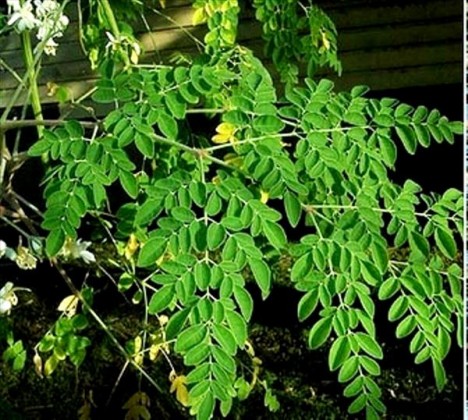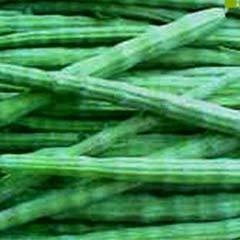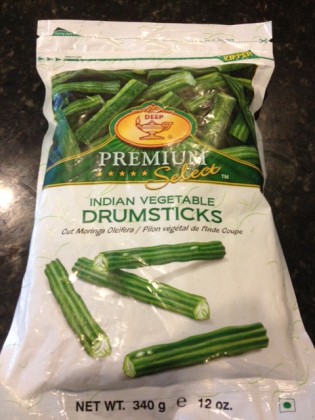It’s quite interesting what research and health discoveries are found in the very foods we thought as just common foods and vegetables. Today Moringa leaves are considered super foods because of its nutritious value. Whereas ten years ago when my uncle from Florida mailed me a bag of Moringa leaves with Moringa drumsticks growing in his backyard, I was unaware what those leaves were and what I was supposed to do with it!
Moringa Drumsticks are nutritious vegetables used often in Indian cuisine in Dal, Sambar soups, or cooked with lamb/ goat for vegetable and meat curry. Moringa seed pods, called “drumsticks” are known to be a good source of vitamin C, B-Complex vitamins, potassium, magnesium and manganese. They are also known to be great source of protein, dietary fiber and useful in fat metabolism.
But the use of leaves of Moringa is not a very common phenomenon. My thank you call to my uncle elaborated the use of these leaves. These lemony flavored green leaves can be cooked like spinach or any leafy vegetable I was told. I hence dropped them in with lentils and spices made a delicious tangy Moringa leaf Dal.
A recent analysis of the leaves found that moringa contains more vitamin A than carrots, more iron than spinach, and more potassium than bananas. It also packs as much protein as milk or eggs.
Check the Articles with this new discovery of benefits of moringa leaves :
http://shopping.yahoo.com/news/the-next-superfood-is-here-and-it-s-called-moringa-225902026.html
http://tonyhortonsworld.com/benefits-of-the-moringa-leaf/
Read more about Moringa : http://en.wikipedia.org/wiki/Moringa_oleifera
Now knowing the newly discovered benefits of the Moringa leaves, we have to start wondering what else growing in our backyard could be an undiscovered super food!
Moringa-Also called Munge ki Phalli(Hindi), Sahajan ki phalli/ Sojini ki phalli(urdu) Mulaga kaya( Telugu), Murangai(Tamil), Sujane (Bengali) Nuggekai (kannada) is available fresh in United States in Indian grocery Stores, and for convenience it’s also available in frozen bags in Indian supermarkets. But for the leaves, one may have to seek fresh leaves from your enthusiast gardeners in family or friends living in Florida where the plants are acclimatized to grow well! The leaves also come in dry powder form is vitamin shops, in tea or as supplements too.
|
See the table below for in depth analysis of nutrients: Moringa (drumstick) pods and leaves, raw, |
||
|
Principle |
Nutrient value-Pods |
Nutrient value-Leaves |
| Energy | 37 Kcal (2%) | 64 Kcal (3%) |
| Carbohydrates | 8.53 g (6.5%) | 8.28% (6%) |
| Protein | 2.10 g (4%) | 9.40 g (17%) |
| Total Fat | 0.20 g (1%) | 1.40% (7%) |
| Cholesterol | 0 mg (0%) | 0 mg (0%) |
| Dietary Fiber | 3.2 g (8%) | 2.0 g (5%) |
|
Vitamins |
||
| Folates | 44 µg (11%) | 40 µg (10%) |
| Niacin | 0.680 mg (4%) | 2.220 mg (14%) |
| Pyridoxine | 0.120 mg (9%) | 1.200 mg (92%) |
| Riboflavin | 0.074 mg (6%) | 0.660 mg (51%) |
| Thiamin | 0.053 mg (4.5%) | 0.257 mg (21.5%) |
| Vitamin A | 74 IU (2.5%) | 7564 IU (252%) |
| Vitamin C | 141mg (235%) | 51.7 mg (86%) |
|
Electrolytes |
||
| Sodium | 42 mg (3%) | 9 mg (0.5%) |
| Potassium | 461 mg (10%) | 337 mg (7%) |
|
Minerals |
||
| Calcium | 30 mg (3%) | 185 mg (18.5%) |
| Iron | 0.36 mg (4.5%) | 4.00 mg (50%) |
| Magnesium | 45 mg (11%) | 147 mg (37%) |
| Phosphorus | 50 mg (9%) | 112 mg (20%) |
| Selenium | 8.2 µg (15%) | 0.9 µg (1.5%) |
| Zinc | 0.45 mg (4%) | 0.60 mg (5%) |






